

By Clément Miège
It might be hard to believe but yes, we are still in town! We have been delayed for a full week now, every day getting ready for a possible flight the next day, and every morning, we get the same message: “Unfortunately, there will be no flight to the ice cap today due to weather and bad visibility with low clouds, but tomorrow looks more promising.” Oh, no! Even if it is fully justified, it is always a bit disappointing the moment you hear that, but I think our team has a good experience already with this kind of delay and we are able to switch quite easily and still be happy and optimistic for a flight the next day.
The main helping factor that puts us back in a good mood comes from the weather forecast. Indeed, every day we are able to see a clear-sky window that makes us think that we will be able to fly the next day. Sometimes, this weather window can be very tiny, but it is always there! Good spirits!
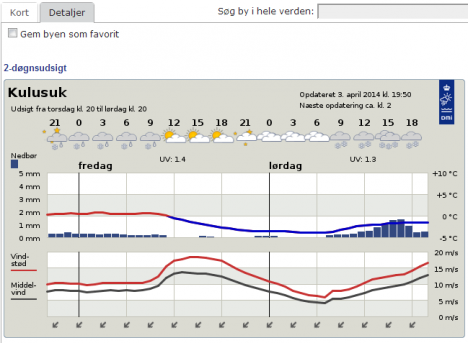
Tomorrow, again, it looks great, with a weather window in the afternoon (Forecast provided by the Danish Meteorological Institute .)
When you look at long-trend forecasts (beyond the following 48 hours), the weather is changing a lot in short spans of time. Often, there are significant changes from one forecast to its updated version a couple of hours later. For example, a 5-day storm, with heavy precipitation, appears in the forecast, but then it it is removed from the next update. So our moods shift quite a bit. For even longer trends, it becomes a different story. Rick shared with Ludo and me his experience with the so-called “Canadian Forecast”. It consists of making the last 5-6 days of a 14-day weather forecast always be nice and sunny, to keep people happy through the winter so they can anticipate the end of it. We can verify this “happy weather trend” in Greenland with our own Danish Forecast — the five last days of this forecast are always sunny. We are keeping a record of the forecast since we arrived two weeks ago, and we can say this is a regular pattern.
After checking weather forecast here, our daily duties are not done yet! Next, we take a look at the data from a weather station that is currently in the field, in our future camp site. We dropped the weather station as part of our cargo last week, but we did not have time to set it up. It is however transmitting data and our IMAU colleagues gave us access to the transmitted data. Unfortunately, the signal for diurnal temperature is getting weak, it’s almost nonexistent anymore, which means that the weather station is getting buried. More and more snow will need to be removed to access our equipment when we will get to camp (maybe tomorrow?) Next, we take a look at the Kulusuk airport’s flight schedule for the day. We can see for example that the Tiniteqilaaq flight is canceled (“aflyst”, in Danish) and that the Isortoq flight is delayed. Then, we do the same thing for the Tasiilaq heliport schedule and then we speculate (while drinking our coffee) where our flight fits in this schedule. We are getting quite good at this exercise! Our flight never fits and we are always rescheduled. But there are some events that are still out of our control. Three days ago, a domestic conflict in Kuummiut required the police Marshall to solve it. Since the Marshall is based in Tasiilaq, the helicopter had to fly him there. That day we had woken up at 5:30 am for a flight scheduled to leave at 7:05, which got rescheduled to 11 am, and after three additional hours waiting at the airport, it eventually became a cancelled flight. Needless to say, the helicopter never made it to the Kulusuk airport. We simply went back to the hotel in the pouring rain. As Ludo likes to say: “This is again craptastic; good times!”
Sunday (March 30) was a beautiful day though, but we were not on the flight schedule — the pilots had to catch up with the Saturday flights had been cancelled. We took advantage of the nice weather to further test our field equipment. As I mentioned in an earlier post we will be testing a low-frequency radar system in the aquifer region on the ice sheet. Laurent Mingo at Blue System, who develops the IceRadar is letting us test a beta version of one of his radar systems. The IceRadar is currently used by many research groups on alpine glaciers, ice caps and ice islands. As such, it has been deployed in many regions of the world (Yukon, Rocky Mountains, Himalaya, Bhutan, Iceland, the Andes, the European Alps…) to perform ice thickness measurements and bed mapping, but also to look at the glacier englacial properties. I believe this is the first trip for the IceRadar to the Greenland ice sheet. So we are quite honored to have this system with us to try it over the aquifer.
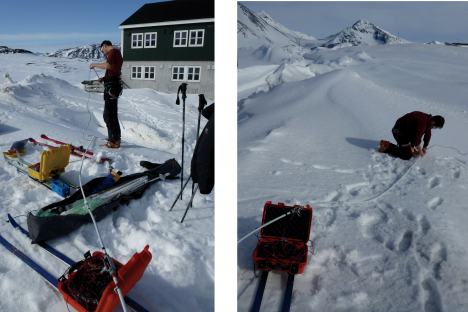
Setting up the IceRadar for the first time in Greenland, with the 5 MHz antennas. The lower the frequency used for the radar, the longer the antenna has to be. For a 5MHz system, the antenna length is 20 meters (about 70 feet), and there are two of them (receiving and transmitting). (Credit: Rick Foster)

After the setup, we try our radar going from the seasonal snowpack to the relatively thin sea ice – that gives us important changes in terms of dielectric constant, which look quite obvious in the radar profile. The system total length is about 50 meters (164 feet), so no sharp turns are allowed! (Photo credit: Rick Foster.)

Getting the 40MHz IceRadar ready, you can see the difference of the antenna size — this is definitely easier to turn. (Photo credit: Rick Foster)
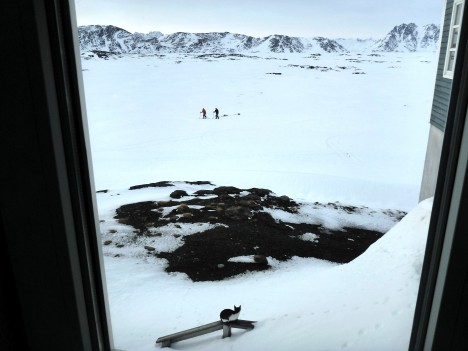
Rick watches Ludo and me maneuvering the IceRadar from the hotel. A new (feline) friend is also observing us, probably wondering what we are doing here! (Credit: Rick Foster.)
At the end of the day we have great news: the IceRadar is working well at the two frequencies tested, which is really promising toward our ice sheet measurements. YAY!
Finally, the hotel still does not have running water. As Ludo mentioned in an earlier blog post, the heating element in the water pipe supply line that prevents the water from freezing broke. And the road to get to the lake with fresh water is still being plowed, but the bad weather and drifting snow prevent the plow truck from making much progress. We are getting used to showering with a water bucket and becoming more and more efficient at conserving water.
Without water at the hotel, we are even more motivated for going to the ice sheet since we know we will not be missing a good hot shower anyway.
Our team has a really good feeling for tomorrow, so let’s hope for a “go” and keep our fingers crossed!
Cheers, Clément on the behalf of the aquifer team.
By Ludovic Brucker
Kulusuk, 31 March 2014 — When I started writing this post, my opening was: Greetings from (still) white-out and windy Kulusuk 🙁
Updated opening sentence: Greetings from now rainy Kulusuk 🙁 🙁
The nice thing about weather forecasts is that they change all the time, so you never get bored watching them. The bad thing about weather forecasts is that they change all the time. What we have been experiencing over the past days was bizarre. We had a storm with sustained high winds and some gusts. We then had temperatures high enough to work outside without a jacket. We also had calm periods alternating every half hour or so with sustained gusting events, so intense that it wasn’t advisable to get near the windows. Now, it is raining.
We spent the last couple of days patiently waiting a phone call or an email. During these days, we made sure to be able to arrive at the airport ready for a put-in flight within an hour notice, if necessary. So far, a good weather window coinciding with availability of the B-212 helicopter and its crew has not happened. We like to think that we will have a flight tomorrow morning. This might happen. As Daniel L. Reardon said: “In the long run the pessimist may be proven right, but the optimist has a better time on the trip.” We are optimists, despite the weather teaching us to be realists.
In the mean time, at the hotel… there is no (liquid) water available anymore since Friday. The pipes bringing the water from a nearby lake are frozen, due to an issue with the pipes’ insulation. This sounds typical here, but usually the hotel’s water tank can get refilled with a winter water truck (please, don’t ask for details, I tried to understand but couldn’t figure this story out completely). But now the road (the only one road) is buried under more than 2 meters of drifted snow. Hence, the winter water truck cannot resupply the hotel’s water tank. We were preparing to melt snow. As Rick thoughtfully mentioned it at breakfast this morning: “if you can’t get to the field, the field will come to you” © Rick Forster. However, the hotel employees went to pick up some big jugs of water for drinking, cooking and even showering at the village! Our record is less than 2 liters used per shower. The colder the water, the less you use of it.
Today, we moved the rest of our cargo up at the airport, including our personal bags. We are really hoping to go to the field soon (that is tomorrow early morning). Keep your fingers crossed for us! Signed: Ludo, one of the three optimists.
By Ludovic Brucker
Kulusuk, 29 March 2014 — For our deployment to the field, we need two flights to bring our scientific equipment and camping gear. As mentioned in our previous post, we decided to avoid being on the ice sheet while the third storm system of the week affects the area. However, thanks to Air Greenland and its helicopter B-212’s crew, we were able to have a first cargo flight to the ice sheet on Thursday afternoon. This will allow us to be fully operational as soon the second flight brings our tents, food, more science gear, and us to the ice sheet!
Thursday morning, we went to the airport to meet with the pilot and hear his point of view about a possible cargo flight that same day. While snow-removing activities of the runway were underway, he shared with us his concern that our cargo (if left on the ice sheet with the current weather system developing offshore) may be blown away or heavily buried in snow. Since we did not have a single item fly away in Antarctica during our SEAT 2011-2012 traverse and its Christmas storm, we will make sure this does not happen in Greenland! Regarding buried items; it’s fine as long as the shovels aren’t buried themselves.
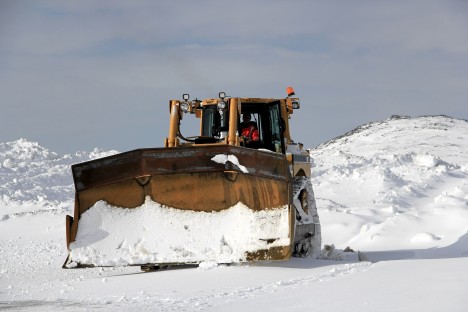
A snow plow removes snow from the second storm of the week at the Kulusuk airport . (credit: Clément Miège.)
In the afternoon, Clem and I took off with the cargo flight to unload it from the helo, and to build the cargo line. The sky was scattered with clouds, sometimes low, but it cleared up as we were approaching the ice sheet.
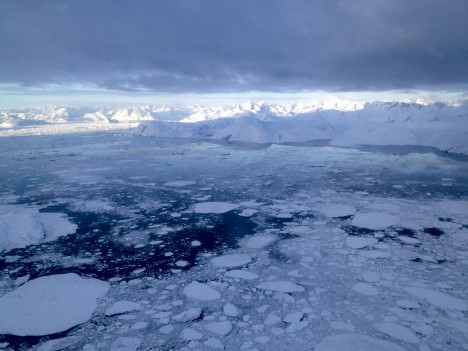
Transit from Kulusuk to our ice sheet location, near the settlement of Tinitequilâq. (Credit: Ludovic Brucker.)
We landed in the vicinity of our temperature probe system and its Argos antenna, which has been sending temperature measurements every day for almost a year now. With the help of the helicopter’s crew, it did not take long to organize a cargo line along the dominant wind direction to minimize snow drift.

Our cargo line on the ice sheet, near the temperature probe and Argos antenna we left behind in 2013. I’m finishing up by deploying a second cargo strap across the line and through the boxes handles. (Credit: Clément Miège)
Our objective was accomplished, the cargo was on the ice sheet. Step 1: Done! Done? Well, of course not. We still had to fly back… But in spite of everyone’s effort, we were not able to fly back to Kulusuk that day. The night was coming quickly and the pilot is not allowed to fly after twilight. Thus, we landed in Tasiilaq 3 minutes after twilight on Thursday. Tasiilaq is on the other side of the bay from Kulusuk, a 15-minute helicopter ride away. Tasiilaq is the largest city on the East coast of Greenland, with about 3,000 inhabitants, and it’s home for the B-212. We landed accurately on the B-212’s kart in front of its hangar so that it could be moved inside quickly. Suddenly, Clem and I were facing a situation for which we were not prepared.
For a less-than-2-hour round trip to the ice sheet, Clem and I were dressed in our warmest layers, and to face a variety of eventualities (including spending an unexpected night on the ice sheet) we had packed a tent, sleeping bags, food, water, extra jackets, gloves, goggles and hats, a satellite phone, two GPS, and a beacon locator. We knew that in our cargo there was more food, a cook stove, propane and white gas; these were in case for the inbound flight. For the outbound flight, we knew that the B-212 has some safety equipment too. That was all we had. But we were facing a different situation now: we were in the largest town of East Greenland, with the perspective of a storm arriving overnight, and forecasted to last several days.
Air Greenland found us a hotel and a warm dinner. Sweet, we wouldn’t be camping on the helipad. Past the first night, we woke up with the exact same landscape as in Kulusuk. I’m serious! Through the windows we could see the same white sky, land, and horizontal snowfall. Visibility? We still don’t know for sure; neither Clem nor I could tell because we had left Kulusuk with our contact lenses on and did not carry our glasses.
Past this first reality check, we headed to breakfast (dressed in our long underwear). We had a specific topic to discuss: what were we going to do during the next hours, days, week? The ideas ranged from finding a book, a toothbrush, an Internet connection, an alternative to water for our contact lenses, learning Greenlandic, finding a boat… Three hours after breakfast, we started a hunt for a set of playing cards to play cribbage. I asked the hotel manager if we could borrow cards from the hotel, or any other game that would keep us busy a few hours, days, a week. He pointed out a souvenir store where we could buy such items. Well, despite knowing that one should take his passport to the field, we did not have money. The hotel manager had a swift idea: “That’s not a problem, you can wash dishes after lunch.” Good times! So, we registered for being the little hands in the kitchen. The next 15 minutes were funny, I was trying to explain this to Clem, and to convince him that it was no joke at all. After lunch, we would be on dish wash duty, dressed in long underwear, and without glasses.
I left for a minute to go back to the room and heard Clem running toward me: “Dress up, we are leaving! The helicopter will take off within the next hour. We must go the airport right now.” Ha, ha, funny Clem, you thought I was joking with washing the dishes, and now you feel the need to make a joke too, but I ain’t a silly fool, and it’s not April 1st yet. Well, when I saw Clem dressing up, and tightening his shoes in a hurry without wasting time to comment further on his statement, let me tell you, I quickly dressed up too! I could not risk missing that flight, if it happened.
Air Greenland was able to fly us back to Kulusuk using a French-made helicopter (an Ecureuil – an Astar helicopter) flown by an Icelandic pilot. Certainly, he was used to windy conditions, and low visibility. We were reunited with Rick for lunch in Kulusuk!
We would like to thank Air Greenland for their dedication to serving our project yesterday and today. Working with us on a flexible schedule to get the cargo flight in yesterday was a big help. Accommodating us in Tasiilaq and getting us back to Kulusuk this morning allowed us to be ready for the next opportunity to fly to the ice sheet so we can begin our experiments. A continued good relationship with Air Greenland and their pilots is important for the success of our science. We view them as team members critically needed to move forward with a successful campaign.
By Clément Miège
Kulusuk, 26 March 2014 — “Opa” is a Greenlandic word for “maybe”, as we learned it this morning while talking to Danish guests at the hotel Kulusuk who have been stuck for a few days due to bad weather.
To give you a little bit of background, the southeastern part of Greenland witnesses the highest precipitation rates of the island, in conjunction with strong winds (either from the ocean or the ice sheet). Often, the weather is unpredictable, especially at this time of year. Therefore, conducting fieldwork in southeast Greenland is a gamble.
Last year, when we experience really great weather in Kulusuk the week before our field work, we did not fully realize how lucky we were to be able to go to the field as scheduled. This year, it has been a different story: we have already gone through two storm systems, and yesterday night a third storm hit us, with a lot of wind and snow. We feel like we are paying the price of last year’s fantastic weather.
That being said, this weather is good to prepare the cargo for our flights to the ice sheet. We spent a good part of Sunday getting the low-frequency radar system ready. We worked on the radar sleds, as well as on the tube that will keep the radar antenna straight when we drag the system on the snow surface.

Ludo and Clem, working on gluing the coupling made to connect the radar antenna tubes. (Credit: Rick Foster.)
On Monday, we went to the village of Kulusuk to buy some supplies (we are currently staying in a hotel that is about a 30-minute walk from the village). On our way to the village, we saw four teams of dog sleds ready to leave for Apusiaajik glacier. The dog sleds are carrying skiers and a week-worth of their base camp materials, so the skiers can enjoy the fresh snow!
We walked around the village to get some nice views of the ocean and the sea ice. As we were walking, Ludo made a local friend! A Greenlandic kid who was a really fun guide and gave us a tour for an hour. At some point, we realized that he was always avoiding the direction of the school!
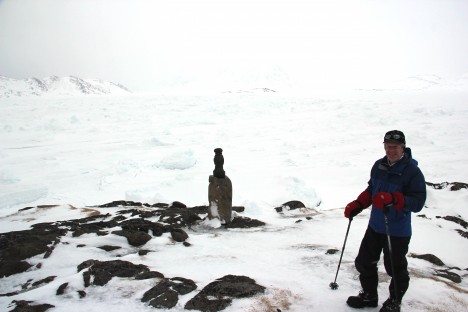
Rick in front of the broken and refrozen sea ice. Imagine how different it is from the open ocean in the summer, with boats cruising around. (Credit: Clément Miège.)
After that, we went to the store and got some food and a propane tank for our stove on the ice sheet. We found everything we needed and headed back to the hotel. We finished the day at the airport further organizing the science equipment.
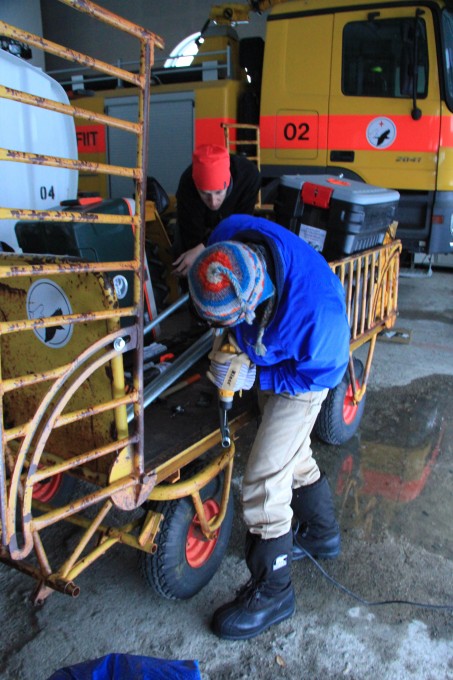
Rick works on an extension of the ARGOS antenna mast that we already have installed in the field. (Credit: Clément Miège.)
Tuesday, Ludo and I went back to the airport warehouse and finished organizing the cargo for the helicopter flights. We’ve prepared two distinct: one consists of our camp gear, sleep kits, food, personal gear, and some science equipment. The other (which can arrive later), is composed by the rest of the science gear.
Wednesday has been different, and we thought it would be “fun” to walk you through the steps that we have gone through today in terms of decision-making:
In the morning, Thursday’s flight is still ‘opa’. We are optimist and getting ready to leave, packing personal bags and organizing the last bits of equipment.
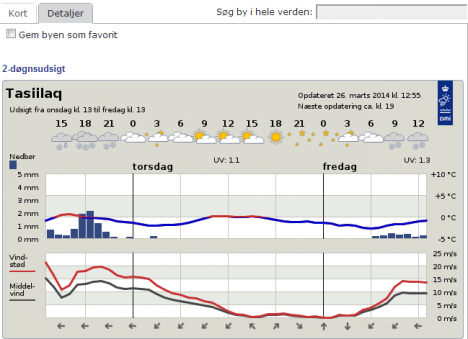
Weather forecast, from the Danish Meteorological Institute, for today Wednesday (March 26) and Thursday (March 27). The good weather window is for Thursday.
2 pm: The weather is not improving much and we start wondering if we will still be able to leave tomorrow. According to the forecast, a break in the storm system is still possible for tomorrow, but we would need it to last for at least a couple of hours, so that we can have one or two helicopter rotations from Kulusuk to our camp on the ice sheet. Each helicopter rotation takes about 2 hours.
3:15 pm: We receive an email from our project manager, based in the US. The helicopter company (Air Greenland) advises us not to leave for the ice sheet tomorrow since an extreme storm is coming for the next days and our team will be incapacitated (meaning that we will not be able to leave the tent for four to six days). This email is worrying us further, and we do not need to be trapped in a tent on the ice sheet without being able to do any work. It is a difficult decision to make, since the weather will be good tomorrow. Moreover, if we leave, we would be able to start working as soon as the storm passed and not be risk further delays in getting to camp, since the helicopter might be needed for other important duties, like resupplying villages. We have to balance the pros and cons — put simply, we have to balance spending four to six days in a tent doing nothing but trying to stay warm vs. gaining about half a day of work, since that way we would not need to wait for our put-in flight. After an intense discussion involving our partners and the weather office, we finally decide that we will not fly tomorrow.
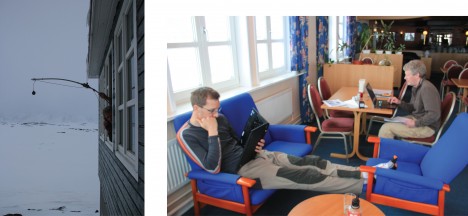
Left: Rick, calling with the satellite phone, using a homemade extended antenna (credit: Ludo). Right: Ludo and Rick waiting to hear back from Air Greenland about tomorrow’s flight. (Credit: Clément Miège.)
4 pm: Our flight for tomorrow is officially canceled.
7 pm: Even if it does not make any sense to have a passenger flight tomorrow due to this upcoming weather system, we think that it will be really valuable to have a cargo flight to drop our equipment. Hence, only one helicopter load will still need to be transported when the storm is over. We’re still working on this option.
We are not sure when we will be flying, but at least we are ready. Please keep your fingers crossed for some good weather. More updates soon, opa!
All the best from snowy Kulusuk!
By Clément Miège
YAY! We made it to Kulusuk on Saturday afternoon! It ended being a not-too-long journey, since all of our flights were on time.
Rick, Ludo and I followed different itineraries. Rick left Salt Lake City on Friday morning and a red-eye flight took him to Keflavik International Airport in Iceland. He landed early Saturday and took a bus from the international airport to the domestic airport in Reykjavik (an hour-long ride).
Ludo came from a meeting in Switzerland and arrived in Iceland late Friday night. He stayed at a nearby hostel in Keflavik. The next day, he was told to take a bus that would take him to the domestic airport and that supposedly departs every hour in the morning. After waiting for a while, with no bus in sight, he walked back to town (carrying 2 duffel bags, a ski bag, and 2 carry-on bags) and learned his first Icelandic words: Saturday and Sunday (laugardaga og sunnudaga.) Turns out, during the weekend, the bus schedule is different. Good thing that taxis were not too far and that he ended up making it on time for his 12:45 pm Greenland flight!
Me, I had a one-day layover in Reykjavik, which was a nice chance to rest a bit and quickly visit the city. I walked around town, not for too long because it was definitely cold and windy and I am not yet acclimated to cold temperatures — but I will be in the next few days!
Reykjavik is a nice city… when it’s not too windy. The day I arrived, the wind was gusting and it was just too cold. But I still went on a walk to check the Hallgrímskirkja church. This is the largest church in Iceland, an amazing structure! Inside, there is a lift, making the church a pretty sweet observation tower with nice views over the city.
[Note: Originally in this post, I erroneously said Halgrímskirja is a cathedral. Thanks to our reader Harry McKone for spotting the mistake!]
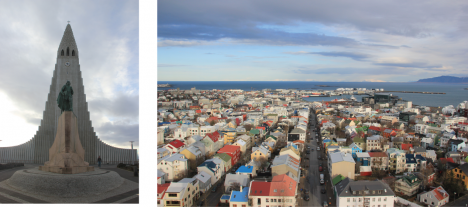
On the left, the church with the statue of Icelandic explorer Leif Eriksson. This story explains the first discovery of North America by a Viking expedition, led by Leif Eriksson about 500 years before Columbus: http://www.history.com/news/the-viking-explorer-who-beat-columbus-to-america. On the right, downtown Reykjavik, composed of colorful houses. (Credit: Clément Miège)
The next day, I joined Ludo and Rick at the domestic airport (they both arrived before me). Useless to say that we had a lot of gear between the 3 of us, a total of 6 carry-on bags (including laptops, radar computer, transmitters, GPS, etc.), 5 checked bags (with our cold weather gear), and 2 ski bags. We were a bit scared at first by Air Iceland’s policy of only allowing one 5kg carry-on and a 20kg checked bag per person, but we ended up getting through easily, which was a relief!
The flight was smooth and fast, only 2 hours to get to Greenland. Approaching Greenland, we started to see more and more winter sea ice along with some big icebergs trapped within it, which is always very pretty. The first islands finally appeared and we were about to land on one of them, where the little town of Kulusuk is.
Interestingly, the sea ice in the fjord next to Kulusuk seemed weaker and it might be thinner this year than when we visited last year. Ludo noticed some spots that were already ice free (see the photo below); those spots were covered by sea ice last April. The wind redistribution of the sea ice and the warm temperature in Kulusuk in January might be the reasons for this weaker sea ice pack.
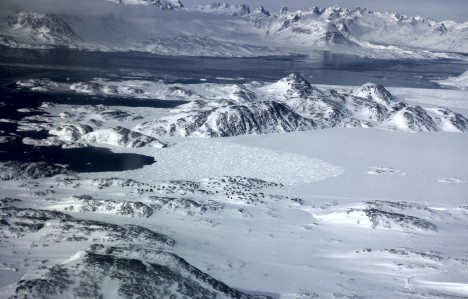
View from the plane of the sea ice around Kulusuk (the little black dots are houses.) (Credit: Ludovic Brucker)
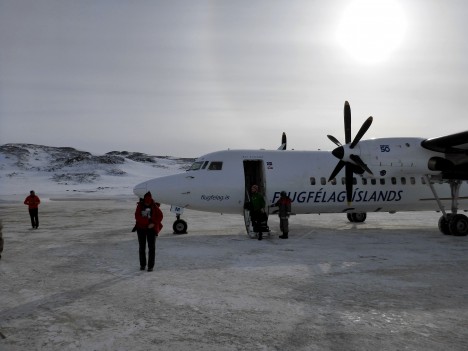
Our plane, freshly landed at the Kulusuk airport, with a faint sun halo in the background. (Credit: Rick Foster)
Shortly after landing, we made it to our hotel, and started to unpack. This year, Ludo and I brought back country skis, which is a really nice and fun improvement, and also a faster way to get from the hotel to the airport, or to go to the old garage where some equipment is stored from last year.
At the airport warehouse, we found all the equipment that we sent from the U.S. We counted the boxes and, great news, everything had made it her, and was in pretty good shape too! We started to unpack some items and took some of them to the hotel for re-organizing them some more.

At the Kulusuk airport, Ludo moves equipment around to consolidate our cargo (left). Some equipment is ready to be loaded on the helicopter (right) to go to our field site, but other gear needs some repacking, which will be one of our main tasks for the coming days. (Credit: Clément Miège.)
Today, a big storm is here and it’s a white-out outside — crazy, brrrrr! It is snowing horizontally. So happy we are not in the field right now! It is really windy this morning, about 37 mph, so we have decided to work indoors. We have couple projects: preparing antenna tubing for the low-frequency radar, preparing the radar sleds, assembling the ARGOS antenna pole, and starting to pull out the equipment from our last year’s storage place.
I can’t take any photos today, since it’s just white everywhere and impossible to see the surrounding buildings.
We are still on track for leaving this Thursday (March 27) to go to our camp site on the ice sheet. Amazingly, the only day of the week that looks good for flying out is Thursday — see the forecast below. That is lucky for us!
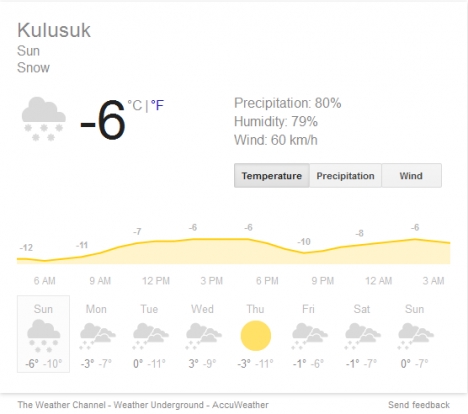
According to the Weather Channel, the only day with good weather this week is Thursday — good thing we are scheduled to leave then!
I’ll send a new blog post in a few days, stay tuned!